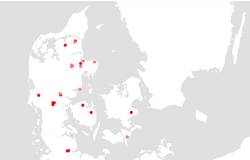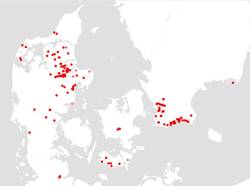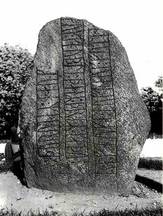- Steering group and management
- Sub-projects
- Jelling in GIS (Geographic Information System)
- Geophysical survey at Jelling
- Fieldwork 2011
- Archaeological fieldwork 2010
- Archaeological fieldwork 2009
- Jelling’s large stones
- The landscape around Jelling
- Place names in Jelling and its vicinity
- The bridge over Ravning Enge
- The travertine churches of East Jutland.
- Rune stones in context 2011
- Power and coins 2009
- Exhibitions
- Digitizing the photographs
Rune stones in context 2011
King Harald’s runic memorial to his parents, the large rune stone at Jelling, is the largest rune stone in the world. Situated in the churchyard at Jelling, just south of the church and between the two large mounds, it is one of the earliest recorded runic monuments in Denmark. With its ornate decoration, the unusual horizontal orientation of the inscription and the textual content, it has attracted much attention, which still continues. Today it is regarded as a manifestation of the Christianisation of Denmark and plays an important role in its national self-esteem; part of the ornamentation even decorates Danish passports. In February this year we were reminded of the continuing importance of this, when the monuments were exposed to vandalism – news that featured on the newspaper front pages for weeks. The rune stone is believed to stand in its original position, at the midpoint between the two mounds.
The smaller rune stone at Jelling, Gorm’s memorial to Thyra, has not attracted as much attention as its younger sibling. The rock is light grey gneiss, and the inscription is carved on the front and back sides of the stone. The only ornamentation consists of two snakes’ heads concluding the inscription on the rear side and the outline of the inscription follows the normal rune stone orientation, with its vertical bands of runes. Compared to the larger Jelling stone, it is a quite small rune stone and is rather modest in appearance. However, it is important to underline the fact that Gorm’s rune stone protrudes c.140 cm high above the surface, in other words it has the typical dimensions of a rune stone of the early or mid 10th century, comparable to the other rune stones from the period (e.g. Bække 1 and 2, Læborg, Haddeby 2 and 4). Whereas Harald’s rune stone is believed to stand in its original position, the original position of Gorm’s rune stone is unknown. However, it is likely that it has had some connection to the supposed pre-Christian ship-setting, as this is frequently the case with other rune stones from the early or mid 10th century (Tryggevælde, Glavendrup and Bække 2).
The aim of this project is to discuss the rune stones at Jelling in the context of the rune stone tradition in Denmark. How does the small Jelling stone fit in the rune stone tradition of the early 10th century, and how does Harald’s runic monument fit in with the change of this tradition at the time of the conversion? How many of the Danish rune stones can be associated with the Jelling complex and what does this tell us about the social importance of this royal dynasty? In order to discuss these problems, it is necessary to clarify the chronological and regional setting of the rune stones in Denmark, as well as to try and establish the original position of rune stones and how this might have changed over time.
At present surveys of the chronological and regional distribution of the rune stones are being carried out. The first map shows the distribution of rune stones in the early and mid 10th century, up until the time of the conversion. Pink dots indicate that the dating is not secure. Note that the rune stone custom has a distinctive distribution in Jutland. The red dots on Funen and Zealand are associated with Ragnhild, who erected both the Glavendrup and Tryggevælde stones, and the rune carver Sote, who carved those at Glavendrup and Rønninge.
The second map shows the boom of the rune stone tradition in the decades after the conversion. With the adoption of Christianity the magnates lost the option of manifesting and maintaining old boundaries with lavish and costly funerals in existing burial areas. As a result the custom of erecting rune stones became popular. Erecting rune stones was an old and distinguished custom, but it was flexible; the rune stones could be placed wherever necessary and the textual content could be adapted to suit the new Christian ideology.
Project coordinator: Museum Inspector Lisbeth Imer, the National Museum.




